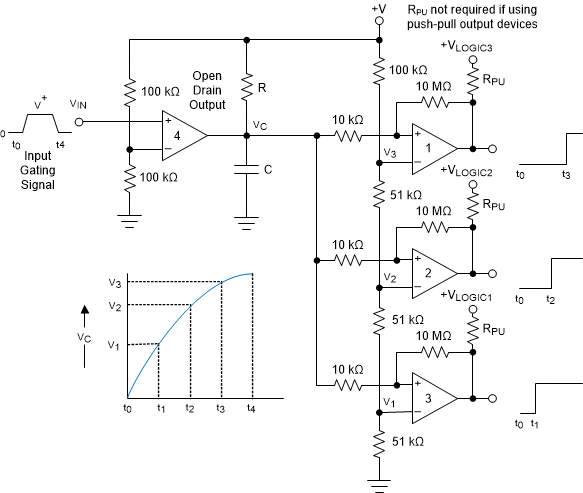JAJSJP5C September 2022 – September 2023 TLV1811 , TLV1812 , TLV1814 , TLV1821 , TLV1822 , TLV1824
PRODMIX
- 1
- 1 特長
- 2 アプリケーション
- 3 概要
- 4 Revision History
- 5 Pin Configuration and Functions
- 6 Specifications
- 7 Typical Characteristics
- 8 Detailed Description
-
9 Application and Implementation
- 9.1 Application Information
- 9.2 Typical Applications
- 9.3 Power Supply Recommendations
- 9.4 Layout
- 10Device and Documentation Support
- 11Mechanical, Packaging, and Orderable Information
パッケージ・オプション
メカニカル・データ(パッケージ|ピン)
サーマルパッド・メカニカル・データ
- DSG|8
発注情報
9.2.4 Time Delay Generator
The circuit shown in Figure 9-13 provides output signals at a prescribed time interval from a time reference and automatically resets the output low when the input returns to 0 V. This is useful for sequencing a "power on" signal to trigger a controlled start-up of power supplies.
 Figure 9-13 Time Delay Generator
Figure 9-13 Time Delay GeneratorConsider the case of VIN = 0. The output of comparator 4 is also at ground, "shorting" the capacitor and holding it at 0V. This implies that the outputs of comparators 1, 2, and 3 are also at 0V. When an input signal is applied, the output of open drain comparator 4 goes High-Z and C charges exponentially through R. This is indicated in the graph. The output voltages of comparators 1, 2, and 3 switch to the high state in sequence when VC rises above the reference voltages V1, V2 and V3. A small amount of hysteresis has been provided by the 10 kΩ and 10 MΩ resistors to insure fast switching when the RC time constant is chosen to give long delay times. A good starting point is R = 100 kΩ and C = 0.01 µF to 1 µF.
All outputs will immediately go low when VIN falls to 0V, due to the comparator output going low and immediately discharging the capacitor.
Comparator 4 must be a open-drain type output (TLV182x), whereas comparators 1 though 3 may be either open drain or push-pull output, depending on system requirements. RPU is not required for push-pull output devices.